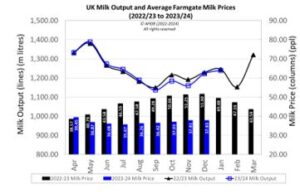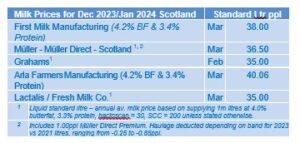Agribusiness News March 2024 – Milk
1 March 2024Milk production data
The latest milk production data from AHDB shows that GB milk output for January was 1,023m litres (provisional), just 0.2% more than December’s volume. Daily deliveries were 33.41m litres (w/e 17th February), 0.4% above the previous week and 1.1% less than the same week in 2023. UK production data for January was 1,238m litres, 1.0% more than the previous month but 0.6% less than January 2023.

Farm-gate prices: March 2024
The Defra average UK milk price for January 2024 was 37.68ppl, down 0.24ppl from December and 24% lower than January 2023. The most up to date milk prices from the main Scottish milk buyers available at the time of writing are shown below.

Dairy commodities & market indicators
The latest wholesale dairy commodity prices for the week beginning 22nd January to the 12th February showed little change from the previous month, with only butter returning a positive price movement (+2%) due to increased EU demand. Trade was reported as relatively quiet as buyers wait to see what the approaching spring flush brings. As a result, the market indicator AMPE was up just 0.21ppl on the back of the higher butter price and MCVE decreased by 0.86ppl.
The latest GDT auction (20th February) returned a 6th consecutive rise in the average price across all products sold, up 0.5% to $3,664/t. This is by far the smallest price rise seen over the last six auctions. Anhydrous milk fat showed the biggest change, up 8.6%. While mozzarella was also up by 5.3%, cheddar showed the biggest decline, down 7.6% to $4,143/t.

Characteristics of top performing dairy farms
The Andersons Centre has recently completed its 2024 report on the characteristics of top performing dairy farms for AHDB. Some of the key attributes associated with the most profitable dairy businesses were:
- Being ruthless with cost control while minimising any impact on milk output or quality.
- Attention to detail by closely monitoring key performance indicators and making changes when performance drops.
- Know the most efficient stocking rate for your farm and look to maximise output from each productive hectare.
- Focus on dairy – better performing farms tended to have less enterprises such as other livestock on the farm.
- Have goals, both financial and non-financial and discuss with key partners/family members/staff to set budgets and draw up business plans.
‘Appendix 1 – Fifty Ways to be Outstanding’ is worth a read and gives practical suggestions on areas to improve and challenge current performance. The full report can be accessed here:
Scottish dairy cattle numbers
Data released by the Scottish Dairy Cattle Association in January this year showed that the number of Scottish herds now stands at 794, a net loss of 10 over the past 12 months. Despite this, the number of dairy cows has increased by 2086 to 180,648 and the average herd size now stands at 227. Ayrshire and Dumfriesshire saw a net loss of 6 and 4 herds respectively, Aberdeenshire and Wigtownshire both saw a net gain of 3 herds.
lorna.macpherson@sac.co.uk
Sign up to the FAS newsletter
Receive updates on news, events and publications from Scotland’s Farm Advisory Service

